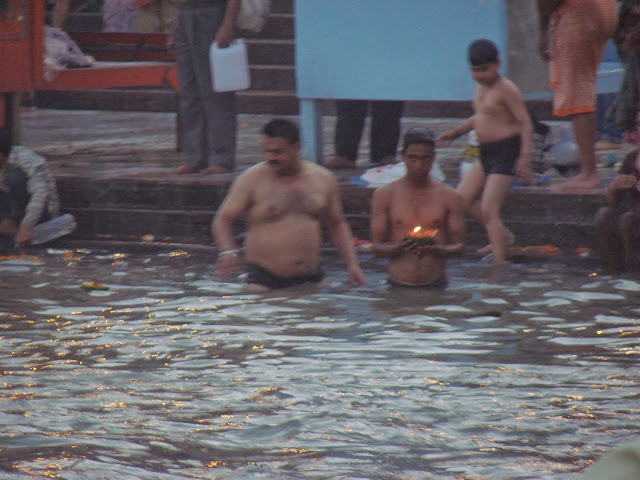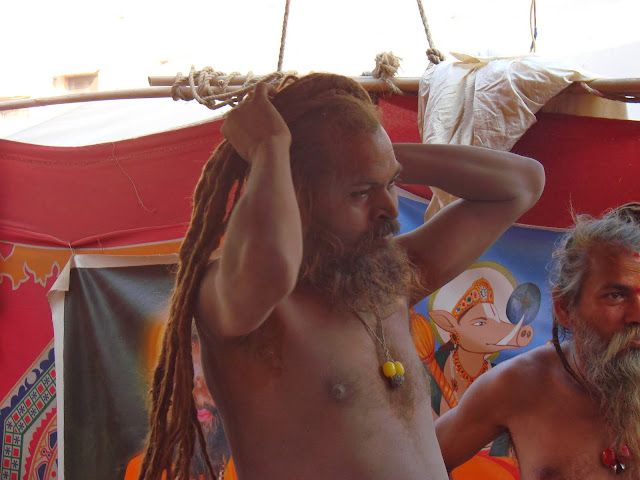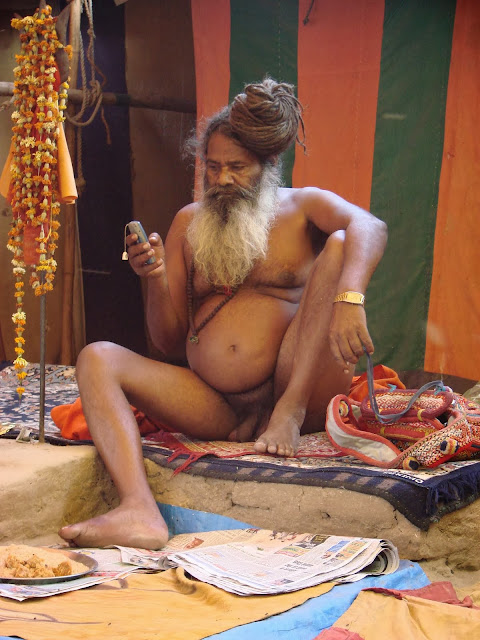The Kumbh Mela is the largest religious gathering on earth which occurs four times every 12 years when tens of thousands of Hindu devotees with no distinction of cast or creed and from all branches of Hinduism come together to take a ceremonial dip in the sacred Ganges, Shipra or Godavari rivers. Locations for the gathering jumps between Allahabad, Haridvar, Ujjain and Nasik, cities where drops of the nectar of immortality were spilled. Each city hosts one mela during the 12-year cycle and here I am going to Haridvar in March 2010.
The story of the Kumbh Mela is linked to a tale in the Vedic scriptures ( the basis of Hinduism), in which demi-gods and demons together churned the milk ocean to produce the nectar of immortality, agreeing to share the nectar equally. Concerned about what might happen if the demons got hold of the nectar, Vishnu grabbed the pitcher (kumbh) containing the nectar and spirited it away; but while escaping, four drops spilt on Earth at Allahabad, Haridvar, Ujjain and Nasik. During the Kumbh Mela, it is believed the waters at the four locations turn into the nectar, cleansing the sins of your lifetime as well as those dating back 88 generations and granting you an escape from the endless cycle of reincarnation by paving a path for salvation or ''Moksha''. So it is very auspicious to bathe in those waters during a Kumbh Mela.
The 12-year cycle is related to the movement of the planet Jupiter through the zodiac; when Jupiter enters Aquarius, the occasion is most auspicious. The exact date is also determined by the lunar cycles. Every Kumbh Mela lasts from two to three months but during that time there are four or five most auspicious dates to bathe and on those days the crowds get bigger. And when I say bigger, I mean bigger since in 2013 the Allahabad Kumbh Mela attracted around 100 million people - 30 times the number of people attending the Haj. Luckily enough, Haridvar was not so crowded on the auspicious day of March 15th, 2010.
Where are we going to stay ? No hotels in Haridvar. But during a Kumbh Mela, the whole city and surroundings up to 14 sq km become covered with tents . So we too stayed in tents but very comfortable ones, since our camp was for rich Hindus and tourists. We even had our toilet and shower in the tent, separated from the bedroom by a zipped partition.
 |
| OUR CAMP |
 |
| WE EVEN HAVE A VERANDA İN FRONT OF OUR TENT |
 |
| THE BEDROOM |
 |
| THE BATHROOM |
 |
| THE SİNK |
 |
| THE SHOWER |
 |
| THE RESTAURANT OF OUR CAMP . ONLY VEGETARİAN FOOD SERVED SİNCE NO MEAT İS EATEN DURİNG A KUMBH MELA . AND BETTER NOT TO EVEN WEAR ANY LEATHER SHOES OR BELT. |
How do you control such a huge number of people during a Kumbh Mela ? How do you attend to their basic needs ? Well the Indian people have an enormous gift for organisation and they manage it very well. At every Kumbh Mela a special governorship is formed, the army is sent, vast tent cities are erected to provide accommodation to the devotees, kilometers of sewage canals are dug to evacuate dirty water from the camps, fresh water and electricity is brought to each and every camp. Just imagine the work required. To make place for the devotees, on very crowded days , all traffic is stopped in the city and people have to walk 8-10 kilometers from their camp to the shore of the river to take their bath. If traffic is closed, do not think the tourist is given any advantage ; he/she also has to walk for kilometers . We were lucky the authorities had not considered March 15th to be that crowded (2 million people only!) and we could approach the Har-Ki-Pairi (Footsteps of the Gods) ghats by minibus instead of walking ( our camp was around 8 km from the holy bathing place). And the temperature was 42 degrees Celsius.
An auspicious day during a Kumbh Mela starts with a procession where very loud music is played. Then Holy Men parade on horses. People like us just watch and take pictures.
Now is the time to take the holy dip in the waters of the Ganges on the Har-Ki-Pairi ghats. As we are very near the Himalayas and the river has just come out of the mountains, the water here is ice cold and runs at great speed which obliged the organisers to put chains to which people can hold to not to be carried away by the Ganga.
After a bath you have to put on clean clothes and then people start wandering around town, eating at food stands, shopping, visiting temples or the tents of some guru they believe in.
 |
| A WOMAN İS ALWAYS A WOMAN. MAKE-UP AFTER A HOLY BATH. |
Every evening hundreds of worshipers gather here again for the ''ganga aarti'' or river worship ceremony. Waiting for the ceremony to start, people still take their dip in the holy waters. And as the sun sets, bells ring out, holy men start reciting hymns, torches are lit, and leaf baskets with flower petals inside and a lit candle on top are put on the river to drift away downstream. I could hear chants, mantras, devotional music and songs all mixed giving the place a divine touch.
 |
| THE GANGES FLOWS AT GREAT SPEED |
 |
| THE HOLY MEN ARE READY |
 |
| AND SO ARE THE DEVOTEES |
 |
| THE BATHİNG GOES ON |
 |
| THE SUN HAS ALMOST SET AND THE CANDLES ARE LİT |
Then the sun sets, the ganga aarti comes to an end, all the lights are lit and Haridvar becomes kind of a Disneyland. So much light, sound and movement. I loved it.
The stars of the Kumbh Mela are the Sadhus. But who are the Sadhus ?
Sadhus are holy men, mystics and ascetics. İn their pursuit of ''inner life'', the liberation from all earthly bonds, they have chosen the way of asceticism and yoga. This implies a systematic re-programming of the body and mind by various methods such as celibacy, renunciation, religious discipline, mediation and austerities. As such, they are regarded as holy men, representatives of the Gods.
Renunciation of the pleasures of the senses starts at the most practical level. Food must be limited to the bare minimum required for the maintenance of the body; one meal a day should suffice and fasting is a regular occurrence. The security and comfort of a home must be given up; living in temples, at the foot of trees or in caves is the ideal. Clothing also is minimal and a Sadhu usually goes on naked, covered in ashes from temple fires which is considered holy, today some wearing an orange gown to hide their nakedness while in a city.



 |
| HE LOOKS VERY MUCH LİKE A GAY SADHU TO ME |
The Kumbh Mela is the most important gathering in the life of Sadhus. It is a very social occasion for them . Sadhus who have not seen each other for years are re-united and everybody enjoys the increased spiritual atmosphere of this reunion.

As previously mentioned, yoga is an important way of attaining control over oneself as well as wisdom.
One important source of bodily pleasure that has to be totally given up is sexuality; but celibacy comes from the conviction that sexual energy can be sublimated into spiritual power and eventually into eternal bliss. So sexual energy must be conserved. Related to sexuality, physical restraint is employed as an aid to mental control of the fire of passion. Some Sadhus wear a tight metal ring around the penis, others do various exercises with the penis among which lifting weights or doing ''chabi'', meaning rolling the penis around something to force sexual energy back up. I could not believe my eyes when I saw a Sadhu doing ''chabi''.
 |
| HE ROLLED HİS PENİS ON A SWORD |
 |
| AND THEN HE LİFTED ANOTHER SADHU ON THE SWORD. |
Usually the jata is worn in a twisted bundle on top of the head and opened only for special moments and rituals.
Another common ritual for Sadhus is the smoking of tobacco and ''charas'' (hashish) in a pipe. Although this undoubtedly serves the more earthly purpose of socialising with Sadhu brothers and devotees, the smoking of charas is none the less regarded as a sacred act. Intoxication as a respected method of self-realisation is recommended in the vedas as a sure mean of attaining divine wisdom.
And some Sadhus do ''tapasya'' as a way to punish themselves for sins they consider having committed. One Sadhu's tapasya was to hold his arm up for 12 years and never put in down. He was said to be in his 8th year and it was a horrible sight since the arm had lost all its purpose and remained standing up as a piece of dried wood. Other forms of tapasya could be not to speak for a number of years or to always stand up even while sleeping , never sitting or even crouching.
 |
| EVEN THE FİNGERNAİLS ARE NEVER CUT |
 |
| THİS MAN HAS VOWED TO ALWAYS STAND UP AND TİES HİMSELF TO THE POLE BEHİND AT NİGHT NOT TO FALL WHİLE SLEEPİNG. |
But as usual, modern times have an influence on even Sadhus and those holy men today possess luxury items such as watches, radios and they use modern conveniences such as electricity, telephone and public transport. But basically their life style has retained many archaic - stone and bronze age - characteristics.
And my trip to Haridvar came to an end. I am so happy to have had the experience of a Kumbh Mela, to have been able to mingle among the devotees, to visit the Sadhus and to have seen and lived it all. To witness such a large gathering composed of all age groups and bound together by faith in a religion is an experience in itself. It set me thinking as to what inspires millions of people to undertake such an arduous journey (some walk for months to reach the river) just in order to have a bath. One word answers the question : the promise of salvation. We all have heard the quote ''Faith can move mountains''. Well in India faith can inspire an ocean of people to have a bath to wash away their sins and pave their way to Heaven.























































































No comments:
Post a Comment